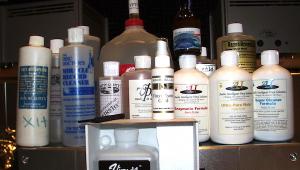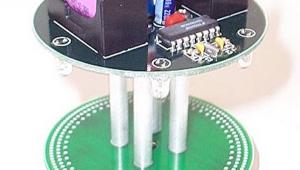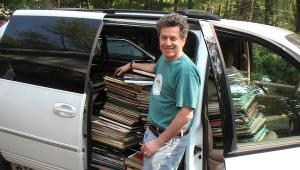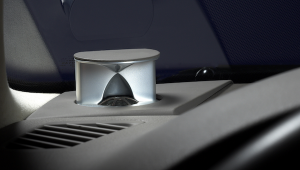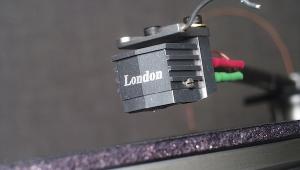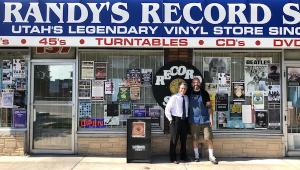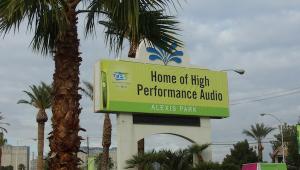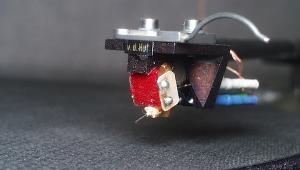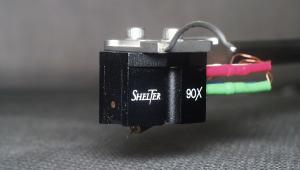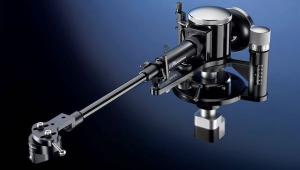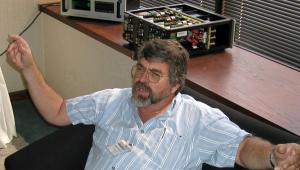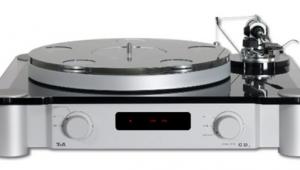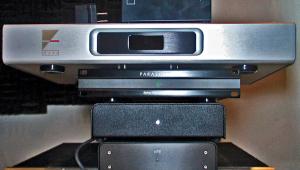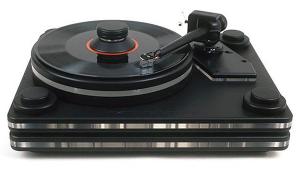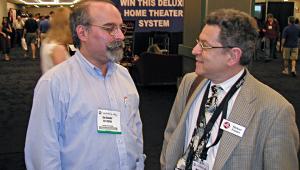Analog Corner #73
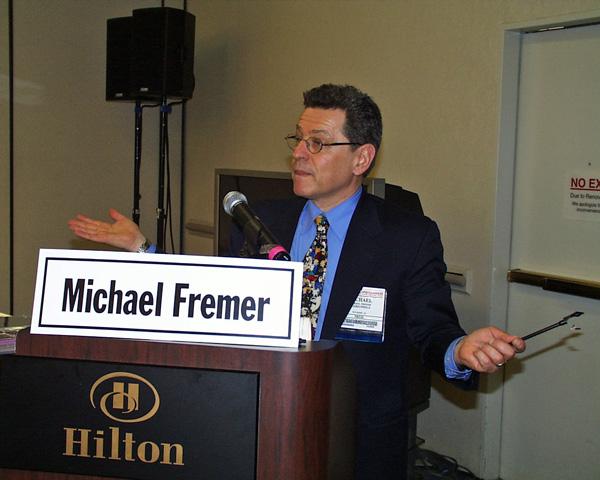
I had no idea what had happened, just that I was supposed to meet audio writer Ken Kessler, Reference Recordings' Jan Mancuso, Chesky Records' David Chesky, and Paul Rosenberg of Mondial/Klipsch at the Carnegie Deli on the eve of the Home Entertainment 2001 Show, and there was no way under or around that yellow tape—in either direction. They could already be in there, Carnegie Deli hostages overdosing on sour pickles and kasha varnishkas, waiting for the tape to come down. Or maybe they'd arrived after the tape went up and, unable to get in, hit the somewhat less enticing Stage Deli on the next block.
As I turned to head in that direction, I saw a downhearted Kessler: poor guy had flown all the way from England for some pastrami, only to be foiled by, as it turned out, a quadruple homicide. We walked to the Stage, wondering if this scene was an omen.
HE 2001—the first New York audio show since 1996, the second under the new emapUSA regime, the first since the aborted 2000 show, and the first in the Hilton venue—had made many actual and would-be participants nervous. Why predict a hit when misses are more commonplace? The addition of home theater to the mix might up the attendance, but with two-channel audio hardly on anyone's radar, the Show had the potential of being a bust. The naysayers were out in force in the months before showtime, predicting a disaster. I don't remember who, but some industry insider assured me that "This will be the last show Stereophile will ever be involved with."
Not to Worry!
As one of two Show spokespersons (the other was Home Theater editor Maureen Jenson), my coverage began a day early with a good-humoredly cantankerous phone-in appearance on The Howard Stern Show. Sample interchange:
"So, Michael, you still have your records?"
"Of course, Howard—around 10,000 of them."
"And do you still have a turntable?"
"Of course!"
"Oy vay!" Stern then asked why.
"Because they sound better."
"Who cares?"
"Well, Howard, why go to Nobu" (an exclusive New York restaurant Stern often mentions) "when there's Mrs. Paul's Fishsticks? Fish is fish."
And on it went for eight minutes or so, during which we talked and argued about SACD, DVD-Audio, and vinyl. Finally, I got to plug Home Entertainment 2001.
"Hey, man! I heard you on Stern!" I heard it over and over during the Show, from Stereophile readers and a surprising number of non-Stereophile readers who spied my badge and remembered my name, which Stern had repeated during the interview. Stern's interviewing skills became increasingly evident over the next few days, as strangers and acquaintances alike asked how long we'd been friends. I've never met the guy, but he'd managed to connect in a way that made it seem as if we'd known each other for years.
The Hilton was crowded Friday morning, when the Show was open to the press and trade only. When the public streamed in later in the day, the crush was overwhelming. It may not have been The Producers, but this off-Broadway show was a big hit—and, as it turned out, home theater was not the biggest draw. Hi-fi and two-channel audio down and out? Downloading MP3s off the Internet and playing them back on a computer the future of audio? Based on this three-day extravaganza, I don't think so! It may now be everywhere, but fast food hasn't killed gourmet restaurants, and there will always be an audience for haute hi-fi.
HE 2001 was easily the best hi-fi show I've attended since joining Stereophile in 1995, and one of the best in my experience, which goes back to shows in the 1960s. I have fond memories of my first, when Henry Kloss introduced the ill-fated KLH open-reel tape deck at the Penn Plaza hotel, across from Madison Square Garden. Home Entertainment 2001 was right up there with that show.
The attendance was phenomenal, but more important, the level of enthusiasm—the energy, the vibe, whatever you want to call it—was incredible. I know this can't be measured and so it must not exist, but I could feel it in the air. I could see it in the faces and by watching young couples seated in front of great-sounding, reasonably priced two-channel audio systems that were a stretch for many, but still within their grasp. I overheard one young couple (who, demographers are convinced, will be downloading their music and listening on plastic computer speakers) turn to one another in excitement and say, "This can be our stereo!" Yes, the elevators were a disaster, and if you weren't comfortable in crowds it could have been traumatic, but few attendees with whom I spoke were anything but pumped up.
The Analog Scene
That first day, I was so busy being the Show's mouthpiece that I didn't get to see any of it. Fortunately for my assignment (analog, of course), there was not a great deal of news just a few months after the Consumer Electronics Show. But there was some.
The Italian V.Y.G.E.R. line of air-bearing turntables has found an American importer: Fanfare International. The Indian, with the new linear-tracking air-bearing arm (tentative prices: $4000 for the arm, $11,000 for the 'table, $15k for both) sounded impressively solid partnered with Audio Valve amps driving Al;aon's four-tower $120,000 behemoth, the Exotica Grande Reference.
Clearaudio's Master Reference turntable, fitted with the stainless-steel Outer Limit record ring and an iteration of the Insider Reference cartridge driving The Groove phono section, was part of "HP's Super System," HP being none other than The Abso!ute Sound's editor, Harry Pearson. The experimental armtube on the Clearaudio/Souther arm was a quartz rod instead of the usual titanium. Other manufacturers participating in the HP Super System room included Conrad-Johnson, VTL (very ecumenical!), Wisdom Audio (planar magnetic loudspeakers), and Nordost. If you're going to have the brass balls to demo HP's Super System at a Stereophile show, it had better sound incredible, but they'd have been better off not doing it at all. I'm not being a cad, but the sound was embarrassingly bad on both LP and CD. Had it sounded good, I'd be saying so. I'd never heard C-J or VTL gear sound excruciatingly bright until that demo. The turntable setup was off, too—there was gross and audible mistracking on a female vocal they played. And what was with that car-stereo bass?
Back down to earth: Music Hall's new MMF-7 'table will definitely come fitted with Goldring's $400 high-output Eroica moving-coil cartridge, making the $999 package the main contender for Analog Deal of the Year. (At CES, Roy Hall hadn't yet decided on a cartridge.)
Much of the analog activity was taking place at the second-floor booths, where the software vendors were, and where Musical Surroundings' Garth Leerer had organized an "Analog Ballroom." Leerer had Basis turntables, Graham's new 2.2 tonearm, and Benz cartridges on display, sharing the space with Rega importer Lauerman Audio Imports and Oracle. Steve Lauerman brought along Rega P2, P3, and P25 'tables, as well as an RB600 tonearm that had been rewired with the highly recommended (by me and others) Incognito harness. Oracle had its turntable with SME 309 arm and a pair of CD players. Whenever I popped in, the Analog Ballroom seemed crowded.
Audio Advancements' Hart Hutchens told me he's selling Morch tonearms as fast as they arrive. (We'll have one or two for review soon.) He also told me that, all of a sudden, Greece and Spain have become hotbeds of analog activity. Must be the olives.
Among the LP (and CD) dealers present on the second floor were Acoustic Sounds, Classic Records, Music Direct, Sundazed, Elusive Disc, Red Trumpet, Cisco (King Super Analogue), Chesky, Telarc, May Audio Marketing, and M•A Recordings. (Reference Recordings was sharing an upstairs room with Kimber Kable.) This was a rare opportunity for vinyl fans to shop till their bank accounts dropped, and according to the dealers with whom I spoke after the Show, that's just what they did.
HE 2001 was the first audiophile show for Sundazed's Bob Irwin, and while he found some of the nonmusical questions odd ("What's your vinyl formulation?") compared to what he's asked at record conventions, he found meeting and getting feedback from audiophiles extremely valuable—especially given the company's push into 180gm vinyl. Irwin had some great news: Along with debuting the 180gm mono edition of Bob Dylan's Highway 61 Revisited, Sundazed would be issuing 180gm LPs from the Elektra catalog. Soon to come: the Love catalog, including Forever Changes, Love, Da Capo, and Four Sail. Five Butterfield Blues Band albums are also set for release. (Irwin told me that East–West is among the best two-track tapes he's heard.) Also coming: Meters, MC5, Byrds (Sanctuary III and IV and Live at the Fillmore), Spirit (not including, unfortunately The 12 Dreams of Dr. Sardonicus, which has been licensed by Scorpio Music), and many more. Irwin told me that he sells many titles as fast as he can press copies, and that business is up 30% over two years ago. Sundazed's new full-color glossy LP catalog is definitely worth picking up.
Classic Records had the first four Led Zeppelin LPs for sale, along with the rest of the label's extensive catalog of 331/3rpm and 45rpm vinyl. Mike Hobson intimated that he'd have some interesting licensing news soon. Over at Acoustic Sounds, I ran into two Analogue Productions recording artists: Jimmie Lee Robinson and Nancy Bryan, both of whom have recent second LPs on the label (331/3 and double 45rpm). Label head Chad Kassem told me that guitar whiz Jimmy D. Lane would soon be entering Blue Heaven Studios to record a new album backed by Double Trouble, Stevie Ray Vaughan's band, with legendary Jimi Hendrix engineer Eddie Kramer at the mixing board. That sounds like it could be interesting!
A corner room in the vendor area contained the largest selection of headphones and headphone amplifiers I've ever seen in one place, courtesy of HeadRoom, who debuted its new version of the Max amplifier. Stax, Grado, and Sennheiser headphones could all be auditioned. John Grado gave me a flyer introducing his new Statement-series cartridges, which will duplicate the Reference series but with lower output (500µV), which means the new series will be compatible with moving-coil phono stages. Prices will be the same as the corresponding high-output Reference series.
According to Grado, the new low-output line has a total of 380 turns of wire on the four coils vs 6000 for the high-output versions. Fewer turns allows larger-diameter wire to be used, which lowers internal resistance from 470 to 2 ohms, and decreases the distance the signal travels through the coils from 125' to 7'. And the magnetic generating gap has been shortened, which increases flux density. Grado claims "better definition and transparency, increased dynamics, enhanced tracking, improved imaging, and more musical information," along with the usual Grado attributes.
VPI's Harry Weisfeld has stayed away from trade and consumer shows in recent years, but with this one so close to home, he took the plunge. Afterward, he told me how glad he was that he'd participated. The crowds were great, and it was an opportunity to meet with VPI owners and analog enthusiasts in general from around the Metropolitan area. Weisfeld demoed the latest VPI TNT turntable with 12" JMW Memorial tonearm. Also on display were his counterweight and VTA mod for Rega arms. Replacing the stock O-ring–mounted counterweight should make a big improvement to the Rega, an inexpensive classic.
Prof. Mikey's Analog Seminar
Counterweight decoupling was one of many subjects I discussed in my hour-long analog seminar at high noon on Saturday. I stuffed into the seminar as much as would fit of what I've learned over the years about tonearms, cartridges, and the Westrex 45/45 cutting system (on which vinyl stereo playback is based), while making sure to answer the questions most often e-mailed to me by readers.
For those of you who weren't there, I preface this recounting as I prefaced the seminar: I am not a physicist, a mathematician, or a mechanical engineer. Worse, conceptualizing this stuff is not one of my strengths. But I figured fresh air is the best cure for chronic misconceptions. And I've found that, even among technicians, many of the topics I tackled in the seminar continue to be subjects of rancorous debate.
There was a full house as I approached the lectern, charts and graphs in hand. I'd requisitioned an overhead projector so everyone could see the visual aids I'd assembled, but, much to my horror, chagrin, and humiliation, I discovered then and there the difference between overhead and opaque projectors: The former is good for transparencies, the latter for paper. I'd brought paper, which meant I'd have to use my hands to describe what I was discussing. Not a good start.
It's obvious from the e-mails I get that "resonant frequency" and "azimuth" are two of the least understood aspects of vinyl playback. I spent a good bit of time explaining those, as well as discussing tonearm geometry in general and how to maximize tonearm performance. The ideal is that the movement of the stylus in the groove creates an electrical signal identical to the one that originally caused the cutting head to engrave the groove in the lacquer. That can occur only if the cartridge is correctly aligned with the record, so that the transducer elements move as the recorded signal is intended to move them.
Because LPs are cut in a straight line, with the cutting tip maintaining perfect tangency to the groove, that is also the ideal way to play them back. But in my opinion, the problems associated with many linear-tracking arms usually result in greater tracking errors than you'll find in a properly set-up pivoted arm. Any linear arm that permits yaw—which can be caused by a variety of mechanical conditions—will describe, instead of the desired radius, a series of differing arcs across the record surface.
There are three essential parameters associated with proper pivoted-arm geometry: overhang, zenith, and azimuth.
Overhang is a forward/back adjustment in which the stylus position coincides with the arm's effective length (the distance from pivot to stylus tip). This produces two "null points" at which the stylus is actually tangent to the groove, while minimizing the tangency error across the rest of the arm's travel and thus minimizing distortion.
Zenith refers to the cartridge's rotation around its vertical axis and relates to having the cantilever parallel to the groove tangent. (Imagine sticking a pin through the top of the cartridge down to the record surface and spinning the cartridge around that axis.) This is especially important with elliptical, line-contact, and other extreme stylus shapes.
Azimuth refers to the cartridge's rotation around its horizontal axis. The goal is to have the transducer planes parallel to the planes of modulation, which in plain English usually means making the headshell parallel to the record surface and the cantilever perpendicular to that surface when the cartridge is viewed head-on. The goal is to minimize crosstalk between the channels so that one channel's modulations don't cause coil or magnet movement in the other channel. Excessive crosstalk causes imaging and separation to suffer. Adjusting azimuth by playing an out-of-phase stereo signal on a test record or reversing the cartridge leads to one channel (and thus putting your cartridge out of phase) and using a mono record to "null" the resulting output does not minimize crosstalk! Doing this merely equalizes the electrical outputs of the two channels, which is a different thing.
I then discussed skating, which is a force caused by friction between the stylus and the rotating record, which pulls the stylus in a direction tangential to the groove. But due to the headshell's offset angle (in a pivoted arm), the skating force is not in line with the arm bearing, so a rotational force is generated that forces the arm toward the center of the record. The force at any given time is dependent on many things: the amount of friction between the stylus and groove wall, the vertical tracking force, the vinyl compound, the degree of groove modulation, and the groove radius at that point on the record.
Skating causes the stylus to lose contact with the right-hand groove wall. Antiskating methods attempt to keep the pressure of the stylus on the two walls of the groove equal. If the right channel sounds distorted at some point across the record, you might need to apply more antiskating. If the left groove distorts, you may have applied too much. A few tonearm designers, like VPI's Harry Weisfeld, believe that because skating force changes across the surface of the record, it's better to ignore it than to apply compromised antiskating. He's in the minority; most arms include antiskating.
I'll skip a few topics, like VTA and damping, and conclude by answering an oft-asked question: "What's my tonearm's resonant frequency?"
A tonearm doesn't have a resonant frequency. The spring-mass system created by the arm and the cartridge's compliance does give rise to a resonance, however, and the goal is for it to fall between 8 and 12Hz, which is above the warp and wow frequencies caused by record-surface irregularities, but below the frequency range of music. If the resonance occurs in the warp/wow range, it will accentuate rumble, create tracking problems, and suck amplifier energy like crazy. If it falls in the music's range, it will muddy the sound and roll off the response 12dB/octave below the resonant frequency. This usually means very weak bass.
There's not space here to explain the mechanics of it, but you don't want to mate a low- or medium-compliance cartridge (stiff spring) with a low-mass arm, or a high-compliance cartridge with a high-mass arm. Think of automobiles, suspensions, and potholes, and you'll get the picture. Stiff springs on a light car give you a bumpy ride. Softer springs drop the wheel into the hole but not the chassis, giving you a smooth ride.
As for decoupled counterweights, these can almost kill the resonance, replacing it with two smaller ones on either side of what would have been a single peak. To be effective, the decoupling frequency must be at or below the resonant frequency, which means a very floppy counterweight. Most so-called "decoupled" counterweights aren't, and if a counterweight's resonant frequency is in the musical range, it actually does more sonic damage than good. That's why the Rega counterweight mods that remove the O-ring mount can improve the sound.
I hope those who attended the seminar found it useful, and that it encouraged many to set up their own turntables instead of relying on others. However, according to an attendee who claimed to be well-versed in physics, I stuck my foot in my mouth when I claimed that the resonant frequency of a low-compliance Clearaudio cartridge (which is why most of them track at +2.5gm) in the low-mass Souther arm couldn't possibly hit the desired 8–12Hz range. I based my claim on my experience reviewing Clearaudio's Reference 'table and arm, and on that of a correspondent who corroborated it. Neither of us could get the arm to resonate in the desired range using a test record. If I'm wrong, I stand corrected. I will attempt to verify the 8–12Hz resonant frequency as soon as possible. How about an invite, HP?
Sidebar 1: Mikey's Top 10 Best Sounds at the Show
In no particular order and missing some associated gear:
Unison Research/Opera speakers
EgglestonWorks speakers/Nagra electronics
JMlab Utopia speakers/Lamm electronics
Immedia/Hovland/Audio Physic Avanti III
Rogue Audio/Audio Physic Tempo
Music Hall/Creek/Epos
Joseph Audio/Spotheim
Lumenwhite/Vaic
Al;aon/V.Y.G.E.R./Audio Valve
Tenor monoblocks.—Michael Fremer
sidebar 2: In Heavy Rotation
1) Bob Dylan, Highway 61 Revisited, Sundazed 180gm mono LP
2) Richard Thompson, Best of the Capitol Years, Bongload 180gm LPs (2)
3) HIM, New Features, Bubblecore CD
4) Jim White, No Such Place, Luaka Bop CD
5) Bill Cunliffe Trio, Live at Bernie's, Groove Note 45rpm 180gm LPs (2)
6) Travis, The Invisible Band, Epic CD
7) Gram Parsons, Anthology, Rhino CDs (2)
8) Emmylou Harris, Anthology, Rhino CDs (2)
9) Otis Redding/Carla Thomas, King & Queen, Sundazed 180gm LP
10) Jon Brion, Meaningless, Straight to Cut Out CD
